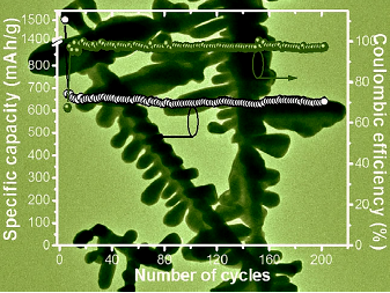Deepak P. Dubal, The University of Adelaide, Australia, Pedro Gomez-Romero, The Barcelona Institute of Science and Technology (CSIC-BIST), Campus UAB, Bellaterra, Spain, and colleagues have used BiVO4 fern architectures as a new anode material for lithium-ion batteries (LIBs). The unique layered structure of monoclinic BiVO4 can facilitate the intercalation/de-intercalation of Li ions to a greater extent than other dense bulk materials. The electrode made of BiVO4 fern-like architecture shows an excellent reversible capacity of 769 mAhg–1 (ultrahigh volumetric capacity of 3984 mAhcm3) at 0.12 Ag–1 with large capacity retention.
As a proof of concept, the team then tested a LIB full cell with BiVO4 fern architecture as an anode and LiFePO4 (LFP, commercial) as a cathode. The device can achieve a capacity of 140 mAhg–1 at 1C rate. That is 81% of the capacity of the cathode. It maintained to 104 mAhg–1 at a high rate of 8C. According to the researchers, the results make BiVO4 a promising candidate as a high-energy anode material for LIBs.
- BiVO4 Fern Architectures: A Competitive Anode for Lithium-Ion Batteries,
Deepak P. Dubal, Deepak R. Patil,Santosh S. Patil, N. R. Munirathnam, Pedro Gomez-Romero,
ChemSusChem. 2017.
https://doi.org/10.1002/cssc.201701483



